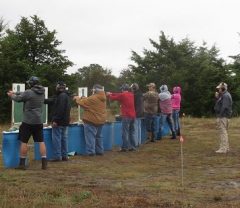The Pistol Learning Curve is my term for the amount of time (or rounds) required for a new shooter to acquire moderately good control and consistency with a given handgun. My definition of moderately good is the ability to hit a paper plate 8 out of 10 times at 7 yards, or 3 out of 4 times at 10 yards. That is hardly an expert marksman, but someone who is competent with a gun, and could defend themselves or family at typical self-defense distances.
The sight-radius, by the way, is the distance between the front and rear sights on a gun. Compare a typical concealable-sized .380 with a .22 target pistol (above) and you will see the difference.
The question at hand is, to what extent does the sight-radius affect the learning time? Note that, in the first sentence above, I said a “new shooter”. An experienced shooter already has a flatter learning curve, due to the experience shooting other guns, and their ability to compensate for the observed differences. The new shooter has no such experience by which to make adjustments.
A longer sight-radius, i.e., longer barrel, makes accuracy easier, because the minute differences in sight alignment become less critical. An alignment error of 1mm on a longer gun has much less impact on accuracy than the same difference on a short gun. New shooters can start hitting that paper plate much sooner with a longer barrel, than with a pocket gun.
Consider this typical scenario:
John Doe is 26, married, with a new baby. He has either never shot a gun, or shot one a few times on his grandfather’s farm when he was 16. He feels the need to provide protection for his growing family. He also has to carry cash sometimes for his company, so it makes sense to get a Concealed Handgun License (CHL) at the same time. He doesn’t want to invest in two guns, so he buys the smallest gun he can find, maybe a .380, or a small 9mm. He reads a few articles online, reads the manual for his gun, then goes to a range and teaches himself. It doesn’t go well. He is overlooking some fundamentals, so by the time he can pass the paper plate test, and feels confidant to take the CHL class, he has spent more money on ammo and range fees than it would have taken to buy a second, longer gun in the first place.
My advice would always be for new shooters to start with a full-size pistol for learning. If a concealable gun is desired later, and the finances are tight, then sell the first gun to get the second. It will then be much easier (quicker, cheaper) to learn the smaller gun. I just wish someone had told me this when I was younger!




